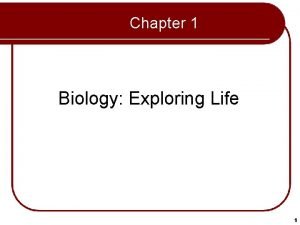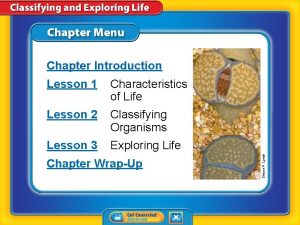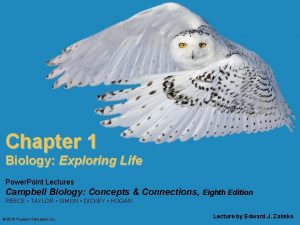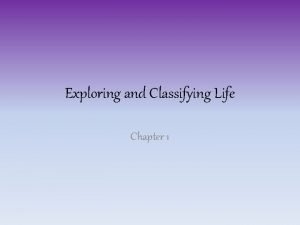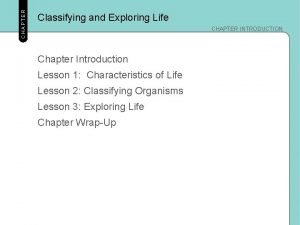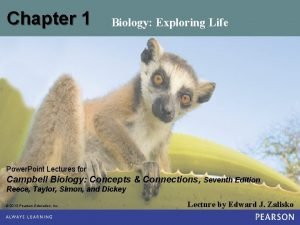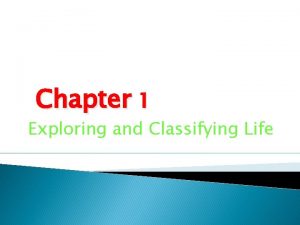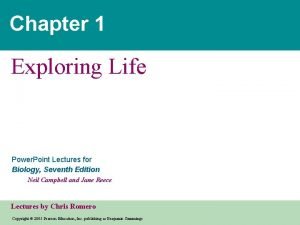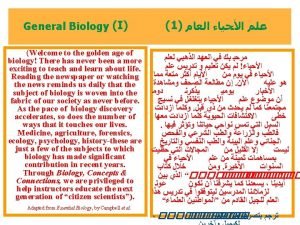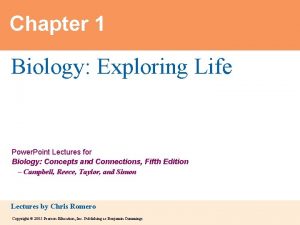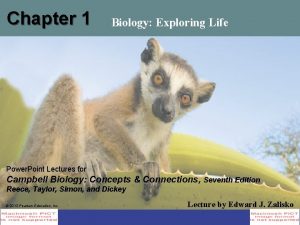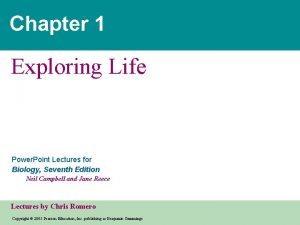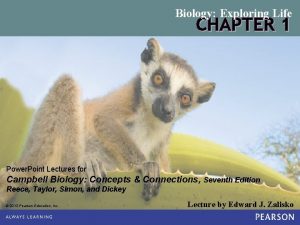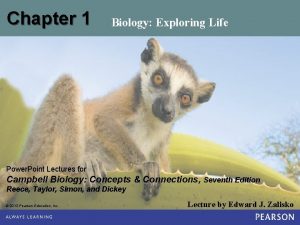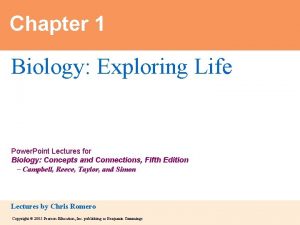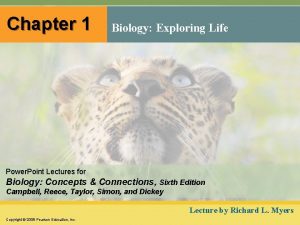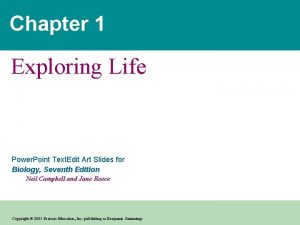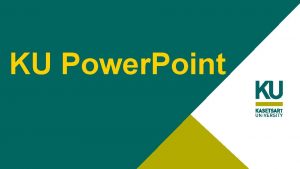Chapter 1 Exploring Life Power Point Lectures for





































- Slides: 37

Chapter 1 Exploring Life Power. Point Lectures for Biology, Seventh Edition Neil Campbell and Jane Reece Lectures by Chris Romero Copyright © 2005 Pearson Education, Inc. publishing as Benjamin Cummings

• Overview: Biology’s Most Exciting Era • Biology is the scientific study of life • Biologists are moving closer to understanding: – How a single cell develops into an organism – How plants convert sunlight to chemical energy – How the human mind works – How living things interact in communities – How life’s diversity evolved from the first microbes Copyright © 2005 Pearson Education, Inc. publishing as Benjamin Cummings

• Life’s basic characteristic is a high degree of order • Each level of biological organization has emergent properties Video: Seahorse Camouflage Copyright © 2005 Pearson Education, Inc. publishing as Benjamin Cummings

Some Properties of Life Copyright © 2005 Pearson Education, Inc. publishing as Benjamin Cummings

Themes Connect Biological Concepts • Concept 1. 1: Biologists explore life from the microscopic to the global scale • The study of life extends from molecules and cells to the entire living planet • Biological organization is based on a hierarchy of structural levels Copyright © 2005 Pearson Education, Inc. publishing as Benjamin Cummings

The biosphere Ecosystems Organelles 1 µm Cells Atoms 10 µm Communities Molecules Tissues Populations Organisms 50 µm Organs and organ systems

A Hierarchy of Biological Organization 1. Biosphere: all environments on Earth 2. Ecosystem: all living and nonliving things in a particular area 3. Community: all organisms in an ecosystem 4. Population: all individuals of a species in a particular area 5. Organism: an individual living thing Copyright © 2005 Pearson Education, Inc. publishing as Benjamin Cummings

A Hierarchy of Biological Organization (continued) 6. Organ and organ systems: specialized body parts made up of tissues 7. Tissue: a group of similar cells 8. Cell: life’s fundamental unit of structure and function 9. Organelle: a structural component of a cell 10. Molecule: a chemical structure consisting of atoms Copyright © 2005 Pearson Education, Inc. publishing as Benjamin Cummings

A Closer Look at Ecosystems • Each organism interacts with its environment • Both organism and environment affect each other • The dynamics of an ecosystem include two major processes: – Cycling of nutrients, in which materials acquired by plants eventually return to the soil – The flow of energy from sunlight to producers to consumers Copyright © 2005 Pearson Education, Inc. publishing as Benjamin Cummings

Energy Conversion • Activities of life require work • Work depends on sources of energy • Energy exchange between an organism and environment often involves energy transformations • In transformations, some energy is lost as heat • Energy flows through an ecosystem, usually entering as light and exiting as heat Copyright © 2005 Pearson Education, Inc. publishing as Benjamin Cummings

LE 1 -4 Sunlight Ecosystem Producers (plants and other photosynthetic organisms) Heat Chemical energy Consumers (including animals) Heat

A Closer Look at Cells • The cell is the lowest level of organization that can perform all activities of life • The ability of cells to divide is the basis of all reproduction, growth, and repair of multicellular organisms Copyright © 2005 Pearson Education, Inc. publishing as Benjamin Cummings

The Cell’s Heritable Information • Cells contain DNA, the heritable information that directs the cell’s activities • DNA is the substance of genes • Genes are the units of inheritance that transmit information from parents to offspring Copyright © 2005 Pearson Education, Inc. publishing as Benjamin Cummings

• Each DNA molecule is made up of two long chains arranged in a double helix • Each link of a chain is one of four kinds of chemical building blocks called nucleotides Copyright © 2005 Pearson Education, Inc. publishing as Benjamin Cummings

Two Main Forms of Cells • Characteristics shared by all cells: – Enclosed by a membrane – Use DNA as genetic information • Two main forms of cells: – Eukaryotic: divided into organelles; DNA in nucleus – Prokaryotic: lack organelles; DNA not separated in a nucleus Copyright © 2005 Pearson Education, Inc. publishing as Benjamin Cummings

LE 1 -8 EUKARYOTIC CELL PROKARYOTIC CELL DNA (no nucleus) Membrane Cytoplasm Organelles Nucleus (contains DNA) 1 µm

The Three Domains of Life • At the highest level, life is classified into three domains: – Bacteria (prokaryotes) – Archaea (prokaryotes) – Eukarya (eukaryotes) Eukaryotes include protists and the kingdoms Plantae, Fungi, and Animalia Copyright © 2005 Pearson Education, Inc. publishing as Benjamin Cummings

LE 1 -15 Bacteria Archaea 4 µm 0. 5 µm Protists Kingdom Fungi 100 µm Kingdom Plantae Kingdom Animalia

• Concept 1. 4: Evolution accounts for life’s unity and diversity • The history of life is a saga of a changing Earth billions of years old Copyright © 2005 Pearson Education, Inc. publishing as Benjamin Cummings

Discovery Science • Discovery science describes nature through careful observation and data analysis • Examples of discovery science: – understanding cell structure – expanding databases of genomes Copyright © 2005 Pearson Education, Inc. publishing as Benjamin Cummings

Types of Data • Data are recorded observations • Two types of data: – Quantitative data: numerical measurements – Qualitative data: recorded descriptions Copyright © 2005 Pearson Education, Inc. publishing as Benjamin Cummings

Induction in Discovery Science • Inductive reasoning involves generalizing based on many specific observations Hypothesis-Based Science In science, inquiry usually involves proposing and testing hypotheses Hypotheses are hypothetical explanations Copyright © 2005 Pearson Education, Inc. publishing as Benjamin Cummings

The Role of Hypotheses in Inquiry • In science, a hypothesis is a tentative answer to a well-framed question • A hypothesis is an explanation on trial, making a prediction that can be tested Observations Question Hypothesis #1: Dead batteries Copyright © 2005 Pearson Education, Inc. publishing as Benjamin Cummings Hypothesis #2: Burnt-out bulb

LE 1 -25 b Hypothesis #1: Dead batteries Hypothesis #2: Burnt-out bulb Prediction: Replacing batteries will fix problem Prediction: Replacing bulb will fix problem Test prediction Test falsifies hypothesis Test does not falsify hypothesis

Deduction: The “If…then” Logic of Hypothesis-Based Science • In deductive reasoning, the logic flows from the general to the specific • If a hypothesis is correct, then we can expect a particular outcome Copyright © 2005 Pearson Education, Inc. publishing as Benjamin Cummings

A Closer Look at Hypotheses in Scientific Inquiry • A scientific hypothesis must have two important qualities: – It must be testable – It must be falsifiable Copyright © 2005 Pearson Education, Inc. publishing as Benjamin Cummings

The Myth of the Scientific Method • The scientific method is an idealized process of inquiry • Very few scientific inquiries adhere rigidly to the “textbook” scientific method Copyright © 2005 Pearson Education, Inc. publishing as Benjamin Cummings

A Case Study in Scientific Inquiry: Investigating Mimicry in Snake Populations • In mimicry, a harmless species resembles a harmful species • An example of mimicry is a stinging honeybee and a nonstinging mimic, a flower fly Flower fly (nonstinging) Honeybee (stinging) Copyright © 2005 Pearson Education, Inc. publishing as Benjamin Cummings

• This case study examines king snakes’ mimicry of poisonous coral snakes • The hypothesis states that mimics benefit when predators mistake them for harmful species • The mimicry hypothesis predicts that predators in non–coral snake areas will attack king snakes more frequently than will predators that live where coral snakes are present Copyright © 2005 Pearson Education, Inc. publishing as Benjamin Cummings

LE 1 -27 Scarlet king snake Key Range of scarlet king snake Range of eastern coral snake North Carolina Eastern coral snake South Carolina Scarlet king snake

Field Experiments with Artificial Snakes • To test this mimicry hypothesis, researchers made hundreds of artificial snakes: – An experimental group resembling king snakes – A control group resembling plain brown snakes • Equal numbers of both types were placed at field sites, including areas without coral snakes • After four weeks, the scientists retrieved the artificial snakes and counted bite or claw marks • The data fit the predictions of the mimicry hypothesis Copyright © 2005 Pearson Education, Inc. publishing as Benjamin Cummings

LE 1 -28 (a) Artificial king snake (b) Artificial brown snake that has been attacked

LE 1 -29 17% In areas where coral snakes were absent, most attacks were on artificial king snakes. 83% Key North Carolina % of attacks on artificial king snakes % of attacks on brown artificial snakes Field site with artificial snakes South Carolina 16% 84% In areas where coral snakes were present, most attacks were on brown artificial snakes.

Designing Controlled Experiments • Scientists do not control the experimental environment by keeping all variables constant • Researchers usually “control” unwanted variables by using control groups to cancel their effects Copyright © 2005 Pearson Education, Inc. publishing as Benjamin Cummings

Limitations of Science • The limitations of science are set by its naturalism – Science seeks natural causes for natural phenomena – Science cannot support or falsify supernatural explanations, which are outside the bounds of science Copyright © 2005 Pearson Education, Inc. publishing as Benjamin Cummings

Theories in Science • A scientific theory is much broader than a hypothesis and has been rigorously investigated. • A scientific theory is: – broad in scope – general enough to generate new hypotheses – supported by a large body of evidence Copyright © 2005 Pearson Education, Inc. publishing as Benjamin Cummings

Science, Technology, and Society • The goal of science is to understand natural phenomena • Technology applies scientific knowledge for some specific purpose Copyright © 2005 Pearson Education, Inc. publishing as Benjamin Cummings
 Power system lectures
Power system lectures Biology exploring life chapter 1
Biology exploring life chapter 1 Active power reactive power apparent power
Active power reactive power apparent power Power bi training powerpoint
Power bi training powerpoint Point point power
Point point power Classifying and exploring life lesson 2 answers
Classifying and exploring life lesson 2 answers Connecting the concepts exploring life
Connecting the concepts exploring life Exploring and classifying life answer key
Exploring and classifying life answer key Classifying and exploring life
Classifying and exploring life Connecting the concepts exploring life
Connecting the concepts exploring life Exploring and classifying life
Exploring and classifying life Rick trebino
Rick trebino Neonatology lectures
Neonatology lectures Data mining lectures
Data mining lectures Medicinal chemistry lectures
Medicinal chemistry lectures Uva orthopaedics
Uva orthopaedics Ludic space
Ludic space Activity based approach in software project management
Activity based approach in software project management Cell and molecular biology lectures
Cell and molecular biology lectures Radio astronomy lectures
Radio astronomy lectures Dr sohail lectures
Dr sohail lectures Utilities and energy lecture
Utilities and energy lecture Introduction to web engineering
Introduction to web engineering How to get the most out of lectures
How to get the most out of lectures Frcr physics lectures
Frcr physics lectures Rotating anode
Rotating anode Cs106b lectures
Cs106b lectures Guyton physiology lectures
Guyton physiology lectures Aerodynamics lectures
Aerodynamics lectures Tamara berg husband
Tamara berg husband Theory and practice of translation lectures
Theory and practice of translation lectures Translation 1
Translation 1 Digital logic design lectures
Digital logic design lectures Kurose
Kurose Hegel philosophy
Hegel philosophy Nuclear medicine lectures
Nuclear medicine lectures Cs106b lectures
Cs106b lectures Cdeep lectures
Cdeep lectures

